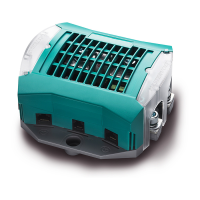OPERATION
6 February 2011 / MasterShunt / EN
3 OPERATION
Figure 1: Overview of the MasterShunt
1. Positive battery pole at battery side
2. Fastening screw on both sides (turn
90 degrees to loosen top)
3. Negative battery pole at battery side
4. MasterBus connector
5. Temperature sensor connector
6. Mounting hole for M8 socket screw
7. MasterBus connector
8. Negative battery pole at load side
9. Flashing communication LED (on
both sides)
10. Positive battery pole at load side
11. Internal fuse
3.1 INTRODUCTION
The Mastervolt MasterShunt provides extended
information about the status of your batteries. This
information includes reading voltage, current, Ah,
time remaining and remaining capacity in
percentage terms.
3.2 MONITORING YOUR BATTERY SET
Your battery bank is monitored in the most accurate
way, i.e. by measuring the voltage and the
(dis)charge current by means of a shunt. Important
is the time factor included in the measurements. This
enables the MasterShunt to determine the state of
charge very precisely.
3.3 FEATURES
• Monitoring of a battery or battery bank
(12/24/48V DC)
• Easy installation
• Can be installed in parallel for larger systems
• Shunt (precise measuring of the battery bank)
• State of charge
• Automatic calculation of Charge Efficiency Factor
• Extensive historical data
• MasterBus network support (Refer to chapter 4
for more information on how MasterBus works)
• Integrated main system fuse in positive DC line
• Solid housing of the shunt with isolation of the
DC connections.
3.4 MASTERBUS DISPLAYS
Mastervolt offers several ways of displaying your
MasterBus data. Shown is the MasterView Easy
panel.
Figure 2: MasterView Easy panel
The MasterView Easy can be connected to one or
more MasterShunts or any other MasterBus product
for monitoring and control.

